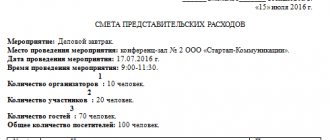Why establish rules for accounting for income and expenses?
The rules in force in both accounting (BU) and tax (TA) accounting provide for the division of income and, accordingly, associated expenses:
- for those related to the main (ordinary) activities of the organization, which serve as the main source of revenue from sales;
- other (non-operating).
This division, despite the enumeration in legislative acts of certain types of activities classified as one or another group, is quite conditional. For example, renting out property can be both the main and other types of activity. Therefore, each specific organization should establish in its accounting policies which types of its activities it considers to be the main ones and which other (non-operating) ones. Expenses related to the relevant types of activities will also be distributed in relation to income.
https://youtu.be/x762ItKAZIE
Tax registers for personal income tax: what is it?
The purpose of the register is to facilitate control of payments made to personnel (broken down by type) for tax purposes (monitoring the correctness of personal income tax accruals and withholdings, providing deductions and accounting for their amounts), and preparing tax reporting - 2-NDFL certificates submitted to the Federal Tax Service upon completion of each year, and quarterly summary forms 6-NDFL.
Such a register is formed separately for each employee. All payments and deductions are recorded monthly. The presence of non-taxable payments does not oblige the employer to indicate them in the register, but if they have restrictions on amounts, the excess of which is subject to taxation, then it is better to indicate them.
The company determines the frequency of compiling the register independently. It is easier and more convenient to do this monthly after salary payment: the risk of incorrect data reflection is significantly reduced, and the information available in the register will always be up-to-date.
Expense breakdowns required for accounting policies
Cost analytics are also developed by the organization independently. It should be carried out not only in relation to each of the departments, but also by type, item and element of expenditure. By type, expenses in accounting will be divided:
- to direct ones, collected on accounts 20, 23, 29 depending on the importance of production (main, auxiliary, servicing);
- invoices, divided into general production (account 25), general economic (account 26), commercial (account 44);
- others (account 91).
For each type of expense, you should develop your own directory of items, detailing it to the extent necessary to quickly obtain from the accounting data the information necessary for drawing up all the necessary reports. For direct costs, the directory will be quite simple, consisting of several articles, and it can be made uniform for all accounts on which these costs are formed. But the lists of items for accounts 25, 26, 44 and 91 are quite voluminous, multi-stage, and are developed separately for each account. All created directories must be included as an appendix in the accounting policy.
The last step in detailing the directories of cost items should be the correlation of the elements of cost items with their relationship to the issue of acceptance for the purpose of accounting for income tax. This will make it possible not only to highlight and classify the types of expenses involved in calculating the income tax base, but also to reflect those elements for which differences will arise between accounting accounting and NU.
A directory of cost items containing data on the correlation of cost elements allocated in the accounting system with the types of expenses involved in calculating the income tax base can serve as a decoding that will reflect the expenses accepted in the accounting system as direct or indirect.
All organizations operating on the general taxation system must maintain tax accounting for income tax in analytical tax accounting registers, the forms of which are developed by the taxpayer independently and must be included in the appendices to the tax accounting policy.
The developers of the 1C:Accounting program have already included them in the configuration and today I will tell you where to find them and how to use them to decipher the data in the income tax return. So, we fill out the income tax return in the program and move on to sheet 02 - tax calculation.
In our article, Income tax return - how to fill it out in the 1C: Enterprise Accounting program 8 , we looked at the issue of comparing the declaration indicators with the data in the balance sheet, but now we will decipher these same indicators using tax registers. You can find them in the Reports :
All registers are divided into four blocks. For us, the main one will be the first one – Registers for generating reporting data.
To decipher line 010 of the declaration of sheet 02 or lines 01., 011, 012 of Appendix 1:
you need to use register 1.01 Income from the sale of goods and services:
In this case, the data will be grouped by type of value: purchased goods and goods of own production, which will allow you to analyze the data on lines 011 and 012 of the declaration. In this case, you can open any implementation document directly from the register by double-clicking with the left mouse button on the desired document.
In the same application, line 100 - Non-operating income can be deciphered using register 1.03 of the same name:
Similarly, you can decipher the data in Appendix 02 to sheet 02 of the income tax return, which reflects various expenses of our organization.
To analyze direct expenses, you need to use register 1.04
To decipher indirect costs, we will use register 1.06. By simultaneously selecting two cells with the type of expenses Taxes and fees and Insurance premiums, we will receive the amount that is reflected in line 041 of Appendix 3 of sheet 02 of the declaration:
I don’t think it’s worth considering all the registers. The main thing is that you understand where to find them and how to use them. I would also like to add that registers printed from the 1C: Accounting 8 program are often sufficient to respond to regulatory authorities to their request to decipher income tax return indicators. Thank you for being with us. Easy reporting companies for you. Stay with us - stay up to date with our news.
| Head of care service Budanova Victoria |
Subscribe to our channel on Telegram
Channel address t.me/bmaxplus
Social buttons for Joomla
What transcripts are needed for the tax authorities?
All of the above lists are needed, first of all, by the organization itself to streamline the accounting process. But they will also serve as the material that will justify the decisions taken by the accounting department and NU on accounting issues.
In particular, for NU purposes it is necessary to determine a list of expenses classified as direct. If an organization wants to avoid the formation of difficult-to-control differences between accounting and accounting records, then in addition to direct production costs, it will also include general production costs (i.e., those that are necessarily included in the cost price for accounting purposes). In this case, all other expenses collected in accounting on accounts 26 and 44 will become indirect for the purposes of accounting.
The tax inspectorate, when checking the validity of the formation of data on expenses in the profit declaration, may request a breakdown of the division of expenses in tax accounting into direct and indirect. For the option when general production expenses are also included as direct expenses, the breakdown of direct expenses will be the lists of items related to accounts 20, 23, 29 and 25. And the breakdown of indirect costs will be the lists of items for accounts 26 and 44.
We bring to your attention a version of such a decoding, compiled for indirect costs allocated for NU purposes, based on the directory of cost items for account 26.
What is a tax accounting register for income tax?
The register is an element of tax accounting. The data contained in the registers must disclose information about on the basis of what documents and how the tax base is formed.
General scheme for setting up tax accounting:
Primary accounting documentation can be used to confirm tax accounting entries. Article 314 of the Tax Code of the Russian Federation states that tax accounting registers must be filled out on the basis of primary accounting documents strictly in chronological order. Errors, disorderly entry of information into registers, and omissions are unacceptable.
Already generated tax registers must be protected from unauthorized correction. If there are any errors in the registers, they can only be corrected if there is appropriate justification. All corrections must be certified by the responsible executor with the obligatory indication of the date.
Data reflected in tax registers is a tax secret. Therefore, administrative or criminal liability is provided for their disclosure.
Is it necessary to give a tax breakdown of income and expenses when checking a declaration?
The Federal Tax Service may request clarification from your organization when conducting a desk audit.
During an on-site inspection, inspectors may request clarifications on identified violations in order to clarify your position on them (Letter of the Federal Tax Service dated August 13, 2014 N ED-4-2/16015).
The tax authority, during a desk audit, has the right to require the taxpayer to provide explanations on expenses and income if, during this audit, errors are revealed in the tax return (calculation) and (or) contradictions between the information contained in the submitted documents and the information available to tax authority and received by it during tax control.
Explanations are drawn up in any form. And during a desk audit of the VAT declaration - in electronic form according to the format approved by the Federal Tax Service (clause 3 of Article 88 of the Tax Code of the Russian Federation, Letter of the Federal Tax Service dated January 11, 2018 N AS-4-15 / [email protected] ).
The content of the explanations depends on whether there are errors in the declaration and how significant they are (what their nature is). Therefore, having received a request from the Federal Tax Service to provide explanations, check whether you have filled out the declaration (calculation) being checked correctly.
Option 1. The declaration is filled out correctly and the tax payable is not underestimated. Then indicate in your explanations that you made no mistakes when filling out the declaration and there are no grounds for correcting it. Also explain why the discrepancies (inconsistencies, etc.) identified by the Federal Tax Service are not an error (Letter of the Federal Tax Service dated November 6, 2015 N ED-4-15/19395).
For example, the Federal Tax Service often requests an explanation of the reasons for the discrepancy between the amounts of revenue in the income statement and VAT returns for the same year. This may be due to the fact that part of your transactions for the sale of goods (works, services) is not subject to VAT.
Option 2. There are errors in the declaration, but they did not lead to an understatement of tax. Often such situations are caused by failures in computer programs or non-compliance with the procedure for filling out the declaration.
In case of such errors, you can indicate in the explanations the reasons for the errors made and the fact that they did not lead to an understatement of the tax. Instead of explanations, you can submit an updated declaration in which errors will be corrected (clause 1 of Article 81, clause 3 of Article 88 of the Tax Code of the Russian Federation).
Option 3. Errors in the declaration led to an understatement of tax. In this case, you must submit an updated declaration to the Federal Tax Service (clause 1 of Article 81 of the Tax Code of the Russian Federation, Letter of the Federal Tax Service dated November 6, 2015 N ED-4-15/19395). It is no longer necessary to provide explanations in such a situation. However, you can do this if you want to inform the Federal Tax Service of the reasons for the mistakes made.
During a desk inspection, the Federal Tax Service has the right to require you to provide additional documents or explanations only in the following situations (clauses 3, 7, Article 88 of the Tax Code of the Russian Federation).
| Situation | What the Federal Tax Service has the right to demand |
| Errors found in the declaration | Explanations or corrected (clarified) declaration (clause 3 of Article 88 of the Tax Code of the Russian Federation) |
| It has been revealed that the information contained in the declaration contradicts the information from the documents you submitted | |
| It was revealed that the information contained in the declaration does not correspond to the information from the documents available to the Federal Tax Service | |
| Documents confirming the accuracy of the information in the declaration (clause 4 of article 88 of the Tax Code of the Russian Federation, Resolution of the Presidium of the Supreme Arbitration Court dated March 15, 2012 N 14951/11) | |
| Loss-making declaration submitted | Explanations justifying the amount of loss (clause 3 of Article 88 of the Tax Code of the Russian Federation) |
| An updated declaration has been submitted in which the amount of tax payable is less than in the previously submitted declaration for the same period | Explanations justifying the reduction of the tax amount (clause 3 of Article 88 of the Tax Code of the Russian Federation) |
| After two years from the last day of filing the declaration, an updated declaration is submitted, in which, in comparison with the previously submitted declaration, the loss is increased or the amount of tax calculated for payment is reduced. For example, an updated VAT return for the first quarter of 2020, in which the amount of tax payable was reduced, was submitted on 04/28/2017 or later | Any documents confirming the validity of reducing the amount of tax payable or increasing the loss, including (clause 8.3 of Article 88 of the Tax Code of the Russian Federation): - source documents; — tax accounting registers |
| Mandatory supporting documents are not attached to the declaration | Documents that must be attached to the declaration (clause 7 of article 88 of the Tax Code of the Russian Federation). For example, documents confirming the zero VAT rate specified in Art. 165 Tax Code of the Russian Federation |
| The declaration states tax benefits | Explanations about transactions (property) for which tax benefits are applied, and documents confirming your right to these benefits (clause 6 of Article 88 of the Tax Code of the Russian Federation). For example, documents confirming the sale of services exempt from VAT according to paragraphs. 2 p. 2, pp. 29, 30 p. 3 art. 149 of the Tax Code of the Russian Federation (Letters of the Federal Tax Service dated December 22, 2016 N ED-4-15/24737, dated November 27, 2014 N ED-4-15/24607) |
| An investment tax deduction is claimed in the income tax return | Explanations and any documents confirming the legality of applying such a tax deduction (clause 8.8 of Article 88 of the Tax Code of the Russian Federation) |
If the explanations or updated declaration requested during the desk audit are not submitted to the Federal Tax Service within five days, the organization will be fined 5,000 rubles. For a repeated violation within a calendar year, the fine will be 20,000 rubles. (clauses 1, 2, article 129.1 of the Tax Code of the Russian Federation).






